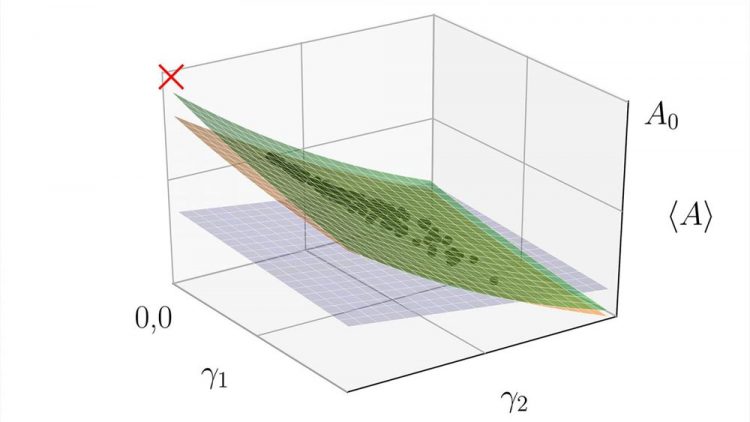Argonne researchers develop new method to reduce quantum noise

This is an example of a 'hypersurface' fit to many experiments with slightly different noise parameters, 1 and 2. Black points are measurements of an observable with different noise rates. The red 'X' is the noise-free result. Blue, orange and green surfaces are first, third and fourth order fits. Credit: Argonne National Laboratory
Many current quantum information applications, such as carrying out an algorithm on a quantum computer, suffer from “decoherence” — a loss of information due to “noise,” which is inherent to quantum hardware. Matthew Otten, a Maria Goeppert Mayer Fellow at Argonne, and Stephen Gray, group leader of Theory and Modeling at the Center for Nanoscale Materials, a U.S. Department of Energy Office of Science User Facility, have developed a new technique that recovers this lost information by repeating the quantum process or experiment many times, with slightly different noise characteristics, and then analyzing the results.
After gathering results by running the process many times in sequence or parallel, the researchers construct a hypersurface where one axis represents the result of a measurement and the other two (or more) axes represent different noise parameters. This hypersurface yields an estimate of the noise-free observable and gives information about the effect of each noise rate.
“It's like taking a series of flawed photographs,” said Otten. “Each photo has a flaw, but in a different place in the picture. When we compile all the clear pieces from the flawed photos together, we get one clear picture.”
Applying this technique effectively reduces quantum noise without the need for additional quantum hardware.
“This is a versatile technique that can be done with separate quantum systems undergoing the same process at the same time,” said Otten.
“One could create several small quantum devices and run them in parallel,” said Gray. “Using our method, one would combine the results on the hypersurface and generate approximate noise-free observables. The results would help extend the usefulness of the quantum devices before decoherence sets in.”
“We successfully performed a simple demonstration of our method on the Rigetti 8Q-Agave quantum computer,” said Otten. “This class of methods will likely see much use in near-term quantum devices.”
The researchers' work described above appears in Physical Review A and is entitled “Recovering noise-free quantum observables.”
Otten and Gray have also developed a similar and somewhat less computationally complex process to achieve noise-reduction results based on correcting one qubit at a time to approximate the result for all qubits being simultaneously corrected. A qubit, or quantum bit, is the equivalent in quantum computing to the binary digit or bit used in classical computing.
“In this approach, we assume that the noise can be reduced on each qubit individually, which, while experimentally challenging, leads to a much simpler data processing problem and results in an estimate of the noise-free result,” noted Otten.
###
This second method was recently published in Nature Partner Journals Quantum Information: “Accounting for errors in quantum algorithms via individual error reduction.”
This research was performed at the Center for Nanoscale Materials, a U.S. Department of Energy User Facility at Argonne, and was supported by the U.S. Department of Energy, Office of Science. Bebop, a high-performance computing cluster operated by the Laboratory Computing Resource Center at Argonne, was used to perform simulations that helped hone the new method and demonstrate it in situations that are not currently available with quantum hardware.
Argonne National Laboratory seeks solutions to pressing national problems in science and technology. The nation's first national laboratory, Argonne conducts leading-edge basic and applied scientific research in virtually every scientific discipline. Argonne researchers work closely with researchers from hundreds of companies, universities, and federal, state and municipal agencies to help them solve their specific problems, advance America's scientific leadership and prepare the nation for a better future. With employees from more than 60 nations, Argonne is managed by UChicago Argonne, LLC for the U.S. Department of Energy's Office of Science.
The U.S. Department of Energy's Office of Science is the single largest supporter of basic research in the physical sciences in the United States and is working to address some of the most pressing challenges of our time. For more information, visit the Office of Science website.
Media Contact
All latest news from the category: Physics and Astronomy
This area deals with the fundamental laws and building blocks of nature and how they interact, the properties and the behavior of matter, and research into space and time and their structures.
innovations-report provides in-depth reports and articles on subjects such as astrophysics, laser technologies, nuclear, quantum, particle and solid-state physics, nanotechnologies, planetary research and findings (Mars, Venus) and developments related to the Hubble Telescope.
Newest articles

NASA: Mystery of life’s handedness deepens
The mystery of why life uses molecules with specific orientations has deepened with a NASA-funded discovery that RNA — a key molecule thought to have potentially held the instructions for…

What are the effects of historic lithium mining on water quality?
Study reveals low levels of common contaminants but high levels of other elements in waters associated with an abandoned lithium mine. Lithium ore and mining waste from a historic lithium…

Quantum-inspired design boosts efficiency of heat-to-electricity conversion
Rice engineers take unconventional route to improving thermophotovoltaic systems. Researchers at Rice University have found a new way to improve a key element of thermophotovoltaic (TPV) systems, which convert heat…



